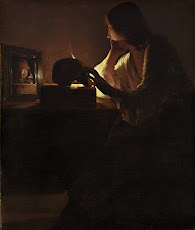Romantic Era - The Clash of Styles: Realism and Post-Impressionism
The Romantic Era
The Romantic Era heralds many art styles used by many well-known artists. Among these, the rise of Impressionism, Realism, Pre-Raphael art, and many more styles are seen during this era, making it one of the most significant flourishes of art. In this article I will be covering realism and post-impressionism and the differences between them.
Realism
Realism appears earlier in the Romantic era and often depicts subjects of ordinary life and individualistic ideals. The evolution of the art of the Classic era into realism can be seen as the realistic depictions track largely through into Realism, however there are key aspects differentiating the two.
Realism is intuitively named after it's realistic, trompe l'oeil (fool the eye) style, mimicking reality. Realism also however carries with it further hidden meanings in the items depicted usually. beyond this, another distinguishing feature of Realism paintings is their focus and nature. Rather than the playful, silly nature of Rococo art, Realism is more dramatic and dreary, though maintaining the realistic anatomy and landscapes seen previously. The change of focus to more reasonable and ordinary items and actions dramatically differentiates the Classical era from the Romantic era.
Allegory of the Four Elements by Cornelis Jacobsz. Delff 1600, Netherlands
Allegory of the Four Elements perfectly exemplifies the hidden messages seen in the Realism style. The piece by Jacobs represents the four elements of fire, water, earth, and air with the depictions of metal pots and pans, fish, vegetables, and open space respectively. The metal pots and pans represent fire through the process of which they would've been made, forged in a furnace. Fish and vegetables inherently live and and grow within their mediums of water and earth respectively. Finally, the realistic depiction of the still-life achieves the last element through the nature of Realism, in the illusion of a space filled with air.
Between these two Realism style paintings the key elements of the style shine through. The aged wooden door in Peto's painting represents the country's status having just struggled with the destruction of the Civil War while Jacobs' still life captures the belief in the four elements of the world of the time. Beyond this, the hyper realistic style that tracks across both of these paintings helps convey the message of reality and can almost fool the eye into believing it is reality.
Post-Impressionism
Post-Impression is marked as an extension and development of the Impressionist style, while rejecting the previous limits and following the path towards expression in art. Impressionism is largely known for the expansion of art into more creative and self expressive forms.
The Impressionism style embodied by well-known artists such as Vincent van Gogh and Pablo Picasso became less focused on the subject of the matter and rather on the expression of oneself. This became far more popular after the Impressionism pioneers detached from religious icons as focuses. The release of a subject to focus on allowed the paintings to become more stylized and unique to the creator's style. Beyond the freedom of expression seen in the Post-Impressionism style, a release of realism is seen, with more abstracted concepts and figures.
Lobster and Cat by Pablo Picasso 1965, Mougins, France
Van Gogh's landscape Mountains at Saint-Remy captures the beautiful rolling hills and mountains without the gritty details but rather cascading lines and brush strokes that guide the viewer's eye across the piece. Picasso and Van Gogh perfectly embody the Post-Impressionism style with abstracted detail and exaggeration of features the express emotion.
Comparison: Realism and Post-Impressionism
The two styles of Realism and Post-Impressionism are drastically different in their very nature. While Realism commits to conveying and representing the grit and drama of ordinary life in grueling detail, Post-Impressionism releases all of the arbitrary rules of art and holds more abstracted detail and expression rather than representation. Realism embodies the mimicry that is often seen in art while Post-Impressionism strays from this path and lends itself more to the expression of the artist. For this reason I find the Post-Impressionism style more interesting to take in as it holds more in it than its face value and is often pleasing to look at and interpret.
Works Cited
“Allegory of the Four Elements, Cornelis Jacobsz. Delff, Minneapolis Institute of Art.” Minneapolis Institute of Art, 2024, collections.artsmia.org/art/62510/allegory-of-the-four-elements-cornelis-jacobsz-delff. Accessed 29 Oct. 2024.
Blessing, Jennifer. “Mountains at Saint-Rémy.” The Guggenheim Museums and Foundation, www.guggenheim.org/artwork/1491. Accessed 29 Oct. 2024.
Licht, Fred. “Lobster and Cat.” The Guggenheim Museums and Foundation, www.guggenheim.org/artwork/3458. Accessed 29 Oct. 2024.






I appreciate the painting you chose to illustrate the Realism style. "The Allegory of the Four Elements" is an outstanding piece that distinctly sets apart the Classical era from the Romantic era. You successfully highlighted the hidden messages in the painting, especially the four elements: fire, water, earth, and air. It's surprising that I didn't notice these details before, but now they stand out clearly. I firmly believe this painting belongs in a science classroom. Excellent blog!
ReplyDelete